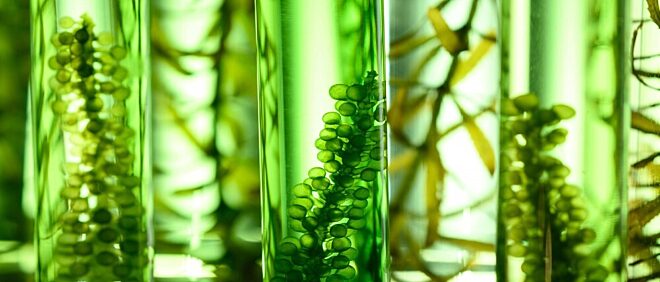
Microbes in food science: the key to a healthier and more sustainable diet?
Could the solution to a healthier, more accessible, and sustainable food system be right under our feet? Here we explore the world of microbes and their potential to offer food system solutions.
The global health and food security crises leave over 800 million people hungry anually, over two billion overweight or obese, and more than two billion malnourished (1). In this blog, we explore a potential food solution that could help to sustainably feed people across the world: microbes.
What are microbes?
Microbes, or microorganisms, are microscopic organisms such as bacteria, viruses, fungi, and algae (2). We can find microbes almost everywhere on the planet and in a range of environments such as water, soil, the air, and in and on the human body (2).
Although some microbes can be harmful to our health, others play an important role in human health and nutrition (2).
Using microbes in food science
Microbes have been used in food science and production for centuries to make products such as bread, cheese, and yoghurt (3). Studies of the microbiome - the community of microbes that live in or on the human body - have mostly concentrated on bacteria, but experts are also increasingly citing the importance of fungi for immune system health (4).
Fungi
Fungi are a kingdom of organisms which range from microorganisms such as yeast and moulds to more complex multicellular organisms such as mushrooms. Fungi have been used for health purposes throughout history. For instance, a group of moulds (a type of fungi) known as Penicillium, formed the basis of penicillin, the antibiotic drug that revolutionised medicine in the late 1920s (4).
Food manufacturers use microbes to make a wide range of food products, primarily using a process known as fermentation (3). Fermentation, a chemical process where molecules such as glucose are broken down by microbes, reduces the growth of unwanted food organisms, improving shelf life and food safety as well as taste and texture in the process (3). Fermentation can be done with a wide variety and combination of microbes. For example, yeasts can be used in the fermentation of fruits to produce wines (3) and another example is a culture containing both bacteria and yeast known as a ‘scoby’ which is used to make a fermented tea called kombucha.
Fungi have also been used as sources of food and for food processing for thousands of years. As our understanding of this complex kingdom of organisms increases, the way fungi are being used in food science is also increasing. In addition to growing and consuming the edible fruiting bodies of fungi, such as mushrooms, some fungi are being used to supplement and add flavour to foods, with recent examples now being introduced to European markets as novel foods.

Algae
We are also seeing an increase in the use of algae as both food ingredients and supplements. Algae are important aquatic microbes, which have a high protein content, and are rich in dietary fibres, micronutrients and bioactive compounds (5) The consumption of algae is therefore considered beneficial for human health (5). Algae have been consumed and used for medicinal purposes since ancient times, with spirulina the most widely consumed algae (6). The production and processing of algae is considered to be a more sustainable alternative to many other protein sources due to algae’s efficient use of solar energy, and rapid growth rate (6). Alternative proteins are estimated to make up 33% of global protein consumption by 2054, and algae is predicted to account for 18% of the alternative proteins market by the same year (7).

Examples of microbe innovation in the food industry
- Enough: Enough is a UK-based biotechnology company in the EIT Food RisingFoodStars scaleup network using a zero-waste process to produce and supply an environmentally and economically sustainable mycoprotein - a protein made from a naturally occurring fungus - as a high-scale food ingredient. Enough was part of the EIT Food project FUNGITIME which aimed to develop healthy food products using mycoprotein which have a high level of consumer acceptance. The food products ranged from snacks and pasta to dairy products, fish-based products, and beverages.
- Vaxa: EIT Food RisingFoodStars alum Vaxa is developing the world’s first production platform that enables year-round production of high quality, pathogen-free, fresh algae. Using a unique combination of culture and light, based on machine learning technology, the algae production is fully controlled and optimised. Vaxa is creating protein and Omega-3-rich products for people, including nutrition supplements, natural colourants, and protein drop-ins for meat substitutes, as well as microalgae for fish feed.
- Microbion: Microbion is a research organisation interested in using molecular microbiology to help innovate in the agriculture, food, and nutraceutical industries. The Italy-based startup provides analysis services and develops tools to understand microbial biodiversity for industry use in fields such as microbe fermentation. Microbion was a partner in the creation of the EIT Food FutureLearn course ‘the human microbiome’, an educational resource about how the microbiome changes throughout your life, the role of food, and the functions the microbiome has in daily life.
EIT Food Open Innovation Call 2023
Have you got an idea for an innovative project that will create positive change in the food system? We want to hear from you!
EIT Food is supporting food innovation to create a future fit food system and microbes have an important role to play in this transformation. Would you like to learn more? Sign up to join the EIT Food community here.
References
- European Commission: Fostering better nutrition
- Institute for Quality and Efficiency in Health Care: What are microbes?
- Microbiology society: Microbes and food: producers
- WEF: How fungi could save the world
- FAO: Seaweeds and microalgae: an overview for unlocking their potential in global aquaculture development
- Elsevier: Microbes in land use change development
- European Commission: Sustainable, Safe and Nutritious food
More blog posts

AgristarBio: Producing the unique Fertilizer







